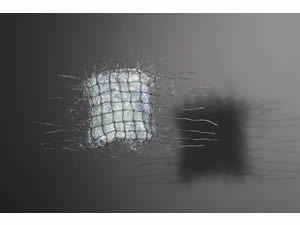
Puni
Le opere di Puni nascono dall’urgenza di trascrivere in materia un’immagine mentale inaspettatamente prospettatasi nel suo pensiero. La codifica dell’oggetto mentale avviene durante il processo di costruzione dell’opera, quando, per concretare l’idea informe, Puni si serve dei materiali che - come in questo caso - trova ad immediata disposizione nel suo studio: del filo di piombo (estremamente duttile), quello di nylon (sensibile alle variazioni di luce), alcune piume sparse sul tavolo di lavoro e una stringa di acciaio.
Dopo aver intrecciato il piombo, l’artista ha srotolato il filo di nylon, riavvolgendolo poi nelle mani quasi per ottenere un movimento fluido in contrasto con l’opaca pesantezza della rete che lo circonda. L’inserimento delle piume è seguito spontaneamente, come pure l’atto conclusivo di suggellare la composizione con la collocazione della stringa di acciaio, segreto custodito dalla parte più diafana dell’opera o più semplicemente sorta di autografo dell’artista. L’intreccio a rete non presenta limiti ben definiti: le solide linee di piombo che confluiscono nei nodi del reticolo si espandono lateralmente come segni grafici tracciati sullo sfondo, facendo procedere la materia nello spazio neutro. La sospensione della scultura nella sala enfatizza il contrasto tra la concretezza materiale dell’oggetto e la sua leggerezza aerea.
L’opera, una volta conclusa, suggerisce la presenza di un intreccio misterioso e non rivelato di un vagabondare in mezzo a passioni presenti o passate e costituisce, per riprendere le parole dell’artista stessa, ‘una rete incerta, dato che i fili, nell’annodarsi, formano una rete cedevole come quella dei trapezisti, sospesa tra terra e cielo, raccolta in se stessa eppure presente, una presenza-assenza in sospensione privilegiata che interloquisce con sé e con il resto’.
Laura Puni’s artworks born by the urgency to transcribe in a material shape, wich appeared unforeseen in her thoughts. She codifies the mental object during the process of building the artwork, using materials – as in this case – founded in her studio to make the formless idea concrete: leaden wire (extremely ductile), nylon wire (sensitive to light’s changings), feathers and steel string. After interlacing the leaden wire, Puni unrolled the nylon wire, then she wrapped it up again on her hands to obtain a fluid movement against the opaque heaviness of the net around it. Afterwards she introduced the feathers and the steel string (the last one is a sort of secret kept in the more diaphanous part of the work or just the artist’s sign). The plot doesn’t show well-defined edges: the solid leaden wires, wich came together in the net’s knots, extend themselves sideways as graphic lines traced on the neutral background. The suspension of the sculpture in the room emphasizes the contrast between the material concreteness of the object and the aerial lightness. Puni feels that this artwork is a mysterious plot of present or past passions and it establishes, as she said, “an uncertain net: the wires, when they get knotted, create a net as yielding as the trapezist’s one, suspended between heaven and earth, that talks with itself and to the others”. Clearly, When does my spirit hyde? brings back again the relation between net and knot to its first meaning: a concrete plot of knotted wires (tissue wires, metal wires, etc.).




